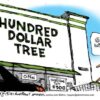What inflation? US import prices drop, consumer sentiment rises
![]()
What inflation? US import prices drop, consumer sentiment rises
Import prices, which exclude tariffs, fell 1.4 percent in July – the largest monthly drop since April 2020.

Published On 12 Aug 202212 Aug 2022
United States import prices fell for the first time in seven months in July, helped by a strong dollar and lower fuel and non-fuel costs, while consumers’ one-year inflation outlook ebbed in August, the latest signs that price pressures may have peaked.
Import prices, which exclude tariffs, fell 1.4 percent last month after rising 0.3 percent in June, the Department of Labor said on Friday.
KEEP READING
list of 4 itemslist 1 of 4
US jobless claims increase for second straight week
list 2 of 4
What the blowout US jobs numbers actually mean
list 3 of 4
US consumer sentiment dropped in early May to lowest since 2011
list 4 of 4
US consumer sentiment remains at decade low as inflation bites
end of list
That was the largest monthly drop since April 2020 and exceeded the 1.0 percent decline expected by economists in a Reuters news agency poll. In the 12 months through July, import prices gained 8.8 percent after a 10.7 percent rise in June, marking the annual rate’s fourth straight monthly decline.
The report followed other tentative indications earlier this week that inflation was finally coming off the boil. US consumer prices were unchanged in July due to a sharp drop in the cost of petrol, after advancing 1.3 percent in June, although underlying price pressures remained elevated. Producer prices also declined last month on the back of lower energy costs.
“Declining import prices and producer prices support the … thesis that the economy is past headline peak inflation,” said Jeffrey Roach, chief economist at LPL Financial.
The Federal Reserve is mulling whether to raise its benchmark overnight lending rate by 50 or 75 basis points at its next policy meeting on September 20-21, as the US central bank battles to cool demand across the economy and bring inflation back down to its 2 percent goal. The Fed has raised its policy rate by 225 basis points since March.
Richmond Fed President Thomas Barkin reiterated following Friday’s data that he and his fellow policymakers will not let up on raising rates until they see long-lasting evidence that price pressures are firmly on a downward path.
“I’d like to see a period of sustained inflation under control, and until we do that, I think we are just going to have to move rates into restrictive territory,” Barkin told CNBC.
Imported fuel prices dropped 7.5 percent last month after surging 6.2 percent in June. Petroleum prices declined 6.8 percent, while the cost of imported food fell 0.9 percent, the largest one-month drop since November 2020 and third straight monthly decline.
Excluding fuel and food, import prices dropped 0.5 percent. These so-called “core import prices” decreased 0.6 percent in June. They rose 3.8 percent on a year-on-year basis in July. The strength of the US dollar is helping keep a lid on core import prices.
Sign up for Al Jazeera
Americas Coverage Newsletter
US politics, Canada’s multiculturalism, South America’s geopolitical rise—we bring you the stories that matter.Sign up

By signing up, you agree to our Privacy Policy
The dollar has gained about 10 percent against the currencies of the United States’s main trade partners since the beginning of the year.
The report also showed export prices fell 3.3 percent in July after accelerating 0.7 percent in June. Prices for agricultural exports declined 3.0 percent, with the fall led by lower prices for soybeans, wheat and cotton.
Nonagricultural export prices fell

































![Lieutenant-Colonel Robert Rogers (7 November 1731 – 18 May 1795) was a British Army officer and frontiersman. Born in Methuen, Massachusetts, he fought in King George’s War, the French and Indian War and the American Revolutionary War. During the French and Indian War, Rogers raised and commanded Rogers’ Rangers, a ranger unit trained for carrying out asymmetric warfare.[2][3](https://www.cowboyron.com/wp-content/uploads/2022/05/1262463_580743685323360_2133853937_o1-1-150x150.jpg)
















![Billie Joe Armstrong & Norah Jones – Silver Haired Daddy Of Mine [Music Video]](https://www.cowboyron.com/wp-content/uploads/2022/11/Al_St._John1-100x100.jpg)























